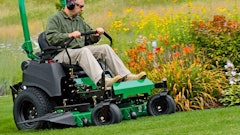
For three days each January, landscapers stroll the aisles of the Baltimore Convention Center, kicking the tires of ride-on mowers, ordering trees for the spring planting season, and generally looking for suppliers who can help them trim costs and increase business in the season ahead.
This year, they were drawn to a new exhibitor at the Mid-Atlantic Nursery Trade Show. A lawyer named Kara Youngblood spent the hours fielding questions from a raft of green-industry employers grappling with a crisis at least as worrying as the economic downturn a decade ago.
"The landscape companies I have met here are livid," she said. The object of their anger? Uncle Sam.
In 2016, Congress failed to renew a provision of immigration law. The result was a significant reduction in the number of foreign temporary workers who are granted H-2B visas. Previously, workers who earlier received a visa, which allows them to work up to 10 months per year in the United States, could return to their employers without coming under the annual limit. Youngblood said the action—or inaction—effectively lowered the number of H-2B workers from about 350,000 to the annual cap of 66,000. It is from this smaller pool that landscapers must compete with all other industry sectors for foreign workers. Half of them are admitted from October to March, further shrinking the availability of workers when landscapers need them.
To read the full original article, please click here.




























